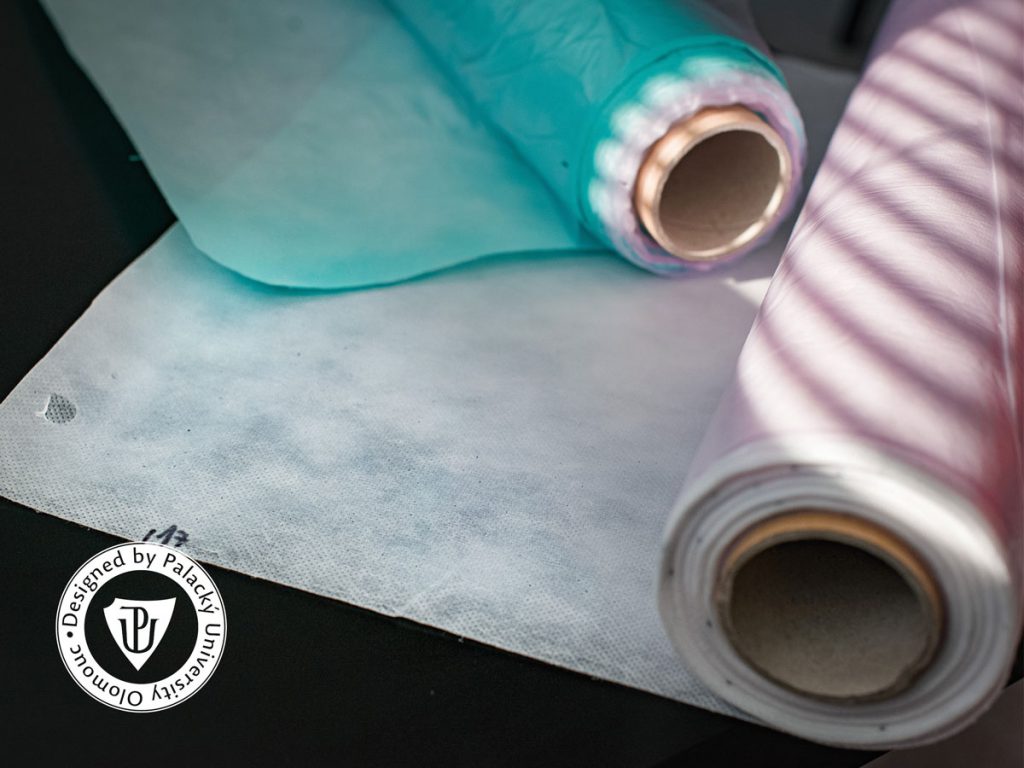New material (not only) for nanofibre face masks has been designed in Olomouc
The nanofibre ArgeCure material suitable for protective face masks, respirators and, in the future, even for water filtration or wound dressing, was developed by scientists from Palacký University (UP) in collaboration with the Science and Technology Park (VTP) of UP and commercial partners thanks to the support of the Technology Agency of the Czech Republic (TACR). To anchor silver nanoparticles, which are effective in the fight against dangerous bacteria as well as viruses, including a new type of coronavirus, researchers have used innovative technology, greatly simplifying the future production of these materials and facilitating their way into practice. Several industrial partners, including a major Czech producer of nanofibres, have already expressed interest in ArgeCure active filters.
“We have a polyurethane-based material at our disposal. The pores between nanofibres are so small that pathogenic organisms can’t get through. In addition, nanofibres are engineered so that we can bind silver nanoparticles to them quite easily, thus preventing the multiplication of trapped viruses and bacteria. If the material is used for a nonofibre face mask or a replaceable respirator cartridge, it will protect the user from the penetration of unwanted microorganisms from the external environment into the airways,” said the grant’s principal investigator Jana Soukupová from the Regional Centre of Advanced Technologies and Materials (RCPTM).
The material not only destroys pathogens from the external environment, but also prevents the growth of bacteria and fungi when used longer. It also combats skin problems caused by these pathogens, which can arise in sensitive individuals when wearing protective equipment. At the same time, the material exhibits a long lifespan.
Scientists have been working on the development of these materials since the middle of last year thanks to the COVID project from the TACR Gama 2 programme. This was one of the reactions to the spring wave of the covid-19 pandemic. Thanks to previous years of research, RCPTM scientists had extensive experience with a similar material, patent-protected in both Europe and the US (R. Zbořil, J. Soukupová, Method of immobilization of silver nanoparticles on solid substrates, patents: US 9505027, EP2701515). The coronavirus crisis has only accelerated the development of a technology that allows scientists to anchor active nanosilver onto the material in a really strong and long-term way. Cooperation with commercial partners involved in the project has also contributed significantly.

Not all masks are the same
Since there are a number of nonofibre face masks currently available on the market, their parameters really matter. “If you want to harness the antimicrobial effects of nanosilver while ensuring that these nanoparticles are safe for the human organism, they need to be covalently anchored and should be in the range of 10 to 50 nanometres. Silver nanoparticles must be bonded by strong chemical bonds so that individual nanoparticles are not released from the material, ending up in the lungs, for example. Our fibre-modification process does just that, which is why we believe that we meet both parameters to the full. To prove this, we are planning a study on a lung model,” said Soukupová, who believes that the safety issue needs close attention.
The material can enhance wound healing as well as improving water filtration
Scientists and their industrial partners still face a three-month testing phase, when they will need to tailor the material to specific applications. There are various possibilities ranging from the use in the textile industry to wound dressing including burns. The material has great potential as part of water filtration systems since its properties make it able to prevent algae and other microorganisms from growing over the filters. For example, tests showed a 99.98 percent effectiveness against Escherichia coli or a 99.68 percent effectiveness against so-called golden staphylococcus. The aim of the current testing will be to confirm outside the laboratory that the individual particles remain in place and perform their function. A number of nanofibres have not been performed such tests on.
The technology protected by both European and American patents, which allows silver nanoparticles to be anchored by strong chemical bonds to various materials including plastics, metals or textiles, have been continuously improved by RCPTM scientists since about 2014. Such antimicrobial coating prevents the growth of bacterial films, and many companies in Europe have already expressed interest in using it. Firm anchoring prevents nanoparticles from being released into the body or the environment.
This project, called PoC2-06 Nano face masks, will end this June, when it is ready to be put into practice. TACR in the Gama 2 programme supported the research of the TP01010015 project under the COVID-19 call with the amount of CZK 2 033 371. The UP Science and Technology Park has already managed to start collaborations with industrial partners. “By linking excellent research to practical needs, you can get more efficient and safer products to customers much faster. Each of us can then get first-hand experience with the benefits Czech science can bring to us in our daily lives,” added the business developer involved in the project Filip Auinger from VTP UP.

